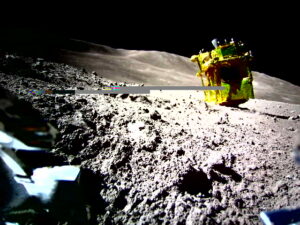JAXA’s SLIM Literally Lost An Engine, and NASA’s LRO Spots SLIM on the Surface
A NASA spacecraft orbiting the Moon has spotted JAXA’s Smart Lander for Investigating Moon, or SLIM, that landed on the surface last week. The lander already was imaged much more closely by one of SLIM’s tiny rovers, LEV-2, showing it landed upside down. Now it turns out one of the engine nozzles fell off during descent.
SLIM soft landed on the Moon at 10:20 am January 19, 2024 Eastern Standard Time (January 20, 12:20 am Japan Standard Time), but upside down. Consequently the solar cells are not pointing toward the sun and cannot recharge the battery. It operated for about two-and-a-half hours before JAXA disconnected the battery to retain the opportunity for recharging to commence when the sun angle changes.

They were able to get back imagery from SLIM’s cameras as well as from one of two tiny rovers that were ejected just before SLIM touched down. The Lunar Excursion Vehicle-2, or LEV-2, a baseball-sized “transformer” built by Japanese toy company Takara Tomy, transmitted an image that shows SLIM with its nose buried in the lunar surface.

JAXA’s Institute for Space and Astronautical Science (ISAS), which manages SLIM, held a press conference in Japanese on January 25 and quickly published English-language press releases summarizing what was discussed. The information included that one of SLIM’s two engines failed at an altitude of 50 meters and was at least partially responsible for the poor landing attitude.
An English-language translation of the slides is now available providing more detail. It turns out the engine did not simply stop performing, but the nozzle fell off. One of the slides has a rendering of the LEV-2 image clearly showing just one engine nozzle pointing upward.

The falling nozzle was seen by one of the lander’s navigation cameras.

JAXA continues to investigate what happened, but overall they met their main criteria for “full” success, which was demonstrating pinpoint landing accuracy. Despite the engine failure, they landed well within 100 meters of the designated spot.
Meanwhile, NASA’s Lunar Reconnaissance Orbiter (LRO) has found SLIM on the surface.
LRO has been making detailed maps of the lunar surface since it arrived in lunar orbit on June 23, 2009. The Lunar Reconnaissance Orbiter Camera or LROC, operated by Arizona State University for NASA’s Goddard Space Flight Center, has two narrow angle cameras with black and white (panchromatic) spatial resolution of 0.5 meters per pixel over a swath of 5 kilometers (km) and a wide angle camera that produces images of 100 meters per pixel in seven color bands over 60 km swath.
Five days after SLIM landed, LRO captured this image at an altitude of about 80 km.

Analysts compared it with an image taken before SLIM landed and created a composite image that highlights the changes in surface brightness from the rocket plume.

LRO also has collected imagery of other lunar landers, both those that survived like China’s Chang’e-3 and Chang’e-4 landers/rovers and Chang’e-5 sample return mission and India’s Chandrayaan-3, and those that crashed like Israel’s Beresheet, India’s Chandrayaan-2’s Vikram lander, ispace’s Hakuto-R M1 and Russia’s Luna 25.
User Comments
SpacePolicyOnline.com has the right (but not the obligation) to monitor the comments and to remove any materials it deems inappropriate. We do not post comments that include links to other websites since we have no control over that content nor can we verify the security of such links.